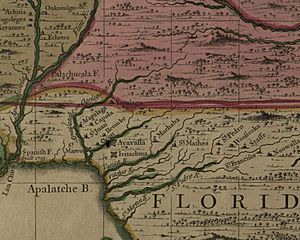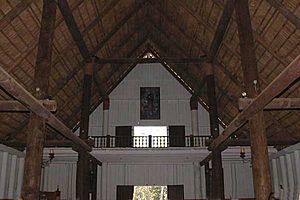Apalachee massacre facts for kids
Quick facts for kids Battle of Ayubale |
|||||||
|---|---|---|---|---|---|---|---|
| Part of Queen Anne's War | |||||||
 A map from 1733 showing the Apalachee Province in Florida. Ayubale is marked "Ayavalla." |
|||||||
|
|||||||
| Belligerents | |||||||
| Commanders and leaders | |||||||
| Strength | |||||||
| 30 Spanish cavalry 400 Apalachee warriors |
50 English traders 1,000 Creek warriors |
||||||
| Casualties and losses | |||||||
| 14 Spanish casualties 200 warriors killed or captured many civilians taken prisoner |
18 English casualties 15 Creek casualties |
||||||
| This battle was the major event of the campaigns by Moore and the Creek Indians against Spanish Florida. | |||||||
The Apalachee raids were a series of attacks by English colonists from the Province of Carolina and their Native American allies. These raids targeted the peaceful Apalachee people in northern Spanish Florida during Queen Anne's War in 1704.
During these attacks, many Spanish missions were destroyed. Most of the Apalachee people were either killed, captured, or forced to flee. Some even chose to join the English.
The most important event of this expedition was the Battle of Ayubale. This battle was the only major fight where the Apalachee and Spanish tried to stop the English attacks. Many Apalachee people were unhappy with Spanish rule. They left their towns and joined the English expedition led by former Carolina Governor James Moore. They were later moved to new areas near the Savannah River and Ocmulgee River.
Other raids happened before and after Moore's expedition. These were mainly carried out by the Creek people, who were allies of the English. These raids, from 1702 to 1709, caused many people to leave Spanish Florida. Only the main towns of Saint Augustine and Pensacola remained populated.
Contents
Why the Raids Happened
English and Spanish efforts to settle in southeastern North America began to clash in the mid-1600s. When the English founded Charles Town (now Charleston, South Carolina) in 1670, tensions grew with the Spanish in Florida. Traders and raiders from Carolina went into Florida, leading to attacks and counter-attacks. In 1700, Carolina's governor, Joseph Blake, threatened the Spanish over their settlement at Pensacola. After Blake's death, James Moore became governor in 1702.
Life in Spanish Florida
The Spanish population in Florida was quite small compared to the English colonies nearby. Since the 1500s, the Spanish had built many missions. Their main goal was to teach local Native Americans about the Catholic faith.
In the Apalachee Province (which is now parts of western Florida and southwestern Georgia), there were 14 mission towns. About 8,000 people lived there in 1680. Many of these towns were home to the Apalachee people. Other tribes also lived there after moving south. By the early 1700s, the Apalachee Province was a key source of food for the Spanish towns of St. Augustine and Pensacola.
The Native Americans in Florida were not always happy with Spanish rule. There had been several uprisings against the Spanish. Native Americans were often forced to work for Spanish soldiers and landowners. This included carrying goods to St. Augustine, which was about 100 miles away. This forced labor and poor treatment caused some Apalachee people to escape to the English in Carolina. Also, Spanish rules did not allow Native Americans to own muskets. This made them rely on the Spanish for protection against the English-armed Creeks.
Earlier Attacks (Before 1704)
News of the War of the Spanish Succession (called Queen Anne's War in North America) reached Carolina by September 1702. Governor Moore convinced the assembly to fund an attack on St. Augustine. This attack, known as the Siege of St. Augustine, failed.
However, the expedition did destroy Spanish mission towns along the coast in Guale Province (now coastal Georgia). After this, Florida Governor José de Zúñiga y la Cerda ordered the remaining Spanish missions to move closer together for defense. In early 1703, Creek warriors attacked some missions. They may have enslaved as many as 500 Native Americans.
The Battle of Ayubale
In 1703, former Governor Moore proposed a plan to attack Spanish towns in Apalachee Province. He promised that the colony would not have to pay for it. He expected to get money and slaves from the expedition. On September 7, 1703, the Carolina assembly approved his plan.
Moore gathered 50 colonists. He then traveled to the Ocmulgee River, where he recruited 1,000 Creek warriors. The Creeks were traditional enemies of the Apalachee.

On January 25, 1704, Moore's force reached Ayubale. This was one of the larger mission towns in Apalachee. While most of the Creeks raided nearby villages, Moore took most of the white soldiers and 15 Creeks into Ayubale.
Father Angel Miranda organized the only resistance. He and 26 men went into the town's church compound, which had a mud wall. They held off the English for nine hours. They only surrendered when they ran out of arrows. According to one Spanish report, Father Miranda and his followers surrendered to Moore. The report states that Father Miranda was killed by Moore's Native American allies, and some of his followers were also killed.
News of the attack reached San Luis de Apalachee, about 24 miles south of Ayubale. Captain Juan Ruíz de Mexía quickly gathered 400 Apalachee and 30 Spanish cavalry. This force fought Moore's group at Ayubale, but they were badly defeated. More than 200 Apalachee were killed or captured. Three Spaniards were killed, and eight were captured, including Captain Mexía. Some Apalachee even joined the English against the Spanish-led forces.
Moore thought about attacking the fort at San Luis. But his force had many injured soldiers. So, he tried to get money instead. He released Father Miranda, Mexía, and others. He hoped the San Luis commander would pay a ransom for them. However, the commander refused to pay.
More Raids in Apalachee
After the battle at Ayubale, Moore continued through Apalachee. One village, San Lorenzo de Ivitachuco, survived. Its leader gave up the church's gold and supplies. Moore moved slowly because many Apalachee seemed to want to leave with the English. According to his report, most people from seven villages joined his group willingly.
In his report, Moore claimed to have killed over 1,100 men, women, and children. He also stated that he "removed into exile" 300 people and "captured as slaves" over 4,300 people, mostly women and children. The only major missions left in Apalachee were San Luis and San Lorenzo de Ivitachuco. The Spanish tried to defend these places, but they were later abandoned. The survivors moved to Abosaya.
James Moore did not name the places his force destroyed. Historians have studied English and Spanish records to figure out which missions were likely destroyed. These include:
- La Concepción de Ayubale
- San Francisco de Oconi
- San Antonio de Bacqua
- San Martín de Tomole
- Santa Cruz y San Pedro de Alcántara de Ychuntafun
Spanish leaders in St. Augustine and Pensacola sent their small forces. But they did not return to Ayubale until Moore's group had left. They buried the Christian dead. Many of the bodies showed signs of violence. Despite these losses, the Spanish did not immediately abandon the missions. But after more raids, the remaining Apalachee insisted they would either go to Pensacola or join the English.
Later Attacks
After Moore's raids, more attacks happened in northern Florida. These were mainly done by the Creeks. In August 1704, Creeks destroyed the Yustagan missions of San Pedro and San Mateo. A year later, they attacked the Apalachee at Abosaya. More attacks on Abosaya caused the survivors to flee to St. Augustine.
By May 1706, many areas were empty. According to scholar John Hann, between Moore's raids and these later ones, 2,000 Native Americans went into exile. An unknown number were enslaved. The French governor of Mobile, Jean-Baptiste Le Moyne de Bienville, wrote that the raids killed 2,000 Apalachee. He also said 32 Spaniards were captured, and 17 of them were burned alive. By the end of 1706, the Spanish presence in Florida was only in St. Augustine and Pensacola.
What Happened Next
All of [this] I have done with the loss of 4 whites and 15 Indians, and without one Penny charge to the Publick. Before this Expedition, we were more afraid of the Spaniards of Apalatchee and their Indians in Conjunction with the French of Mississippi, and their Indians, doing us Harm by Land, than of any Forces of the Enemy by Sea. This has wholly disabled them from attempting anything against Us by Land.
Many survivors of the raids fled west to the French settlement of Mobile. Others went to St. Augustine or Pensacola. Governor Bienville reported that about 600 refugees settled near Mobile. The Apalachee taken by Moore were resettled near the Savannah River or among the Creek people on the Ocmulgee River. These free Apalachee refugees were often bothered by slave traders. In some cases, Native Americans taken as slaves were freed after people complained to Carolina leaders.
The Spanish responded by encouraging privateers to attack Carolina's coastal plantations. In the years that followed, the English colonists continued to push against Spanish and French interests in Florida. However, they were never able to capture St. Augustine, Pensacola, or Mobile. Pensacola was attacked twice by Creek forces in 1707, likely with English support. English-backed Native Americans also raided French areas to the west.
How Historians See It
Historians have written different accounts of how many Native Americans were enslaved. This is because the old records about these raids are not always clear. Although Moore claimed many Apalachee were enslaved, modern historians believe that many of those moved by Moore went willingly. They were not actually slaves.
Historian Vernon Crane, in his 1929 book, accepted Moore's numbers. Edward McCrady, a 19th-century historian, mentioned only 1,400 Apalachee were taken, with only 100 being slaves. However, historian Allan Gallay believes that the raids in 1704 alone led to 2,000 to 4,000 Native Americans being enslaved.
There are also different ideas about what happened to the Native Americans who willingly went with Moore. A census in 1715 counted fewer than 650 Apalachee in the Savannah River settlements. Allan Gallay thinks the rest were probably sold into slavery. James Covington believes that many things caused the difference. Besides slaving, disease, hunger, marriage with other tribes, and moving to other communities also played a part.
Images for kids
See also
 In Spanish: Masacre de Apalache para niños
In Spanish: Masacre de Apalache para niños



